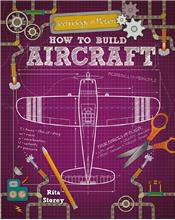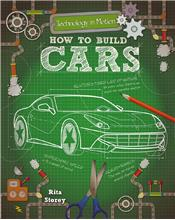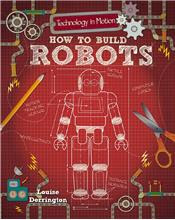| ________________
CM . . . . Volume XXIV Number 30. . . .April 6, 2018
excerpt:
The “Technology in Motion” series by Crabtree is a set of three books that teachers and librarians might be predisposed to purchase since the focus is building working models of aircraft, cars, and robots in contrast to reading about the work of Science, Technology, Engineering, and Mathematics (STEM) professionals and/or STEM careers. In How to Build Aircraft, author Rita Storey provides step by step directions for a hot air balloon, a folded paper roto copter, propeller shaped craft stick and pencil whirligig, three gliders, a rubber band helicopter, and a rubber band plane. Templates are also provided for the catapult and Bernoulli gliders and the two rubber band powered aircrafts. In How to Build Cars, Storey includes directions for making vehicles that are powered by an inflated balloon, a tightly wound rubber band, AA batteries and small electric motor, a motor with a worm drive gear box, or a solar powered micro motor. Templates are provided for the motorized car with gears and the solar car. Louise Derrington, the author of How to Build Robots, helps readers to build seven robots. Two are human manipulated robotic hands, one is a desktop fan that uses a solar powered micro motor, and four are motorized with AA batteries. The motor for the Bristlebot is taken out of an electric toothbrush (see third excerpt above), 1.5 V DC motors are used in making the Scrub bot and the drawing robot, and Robbo the robot requires a 3V worm drive gear box kit. As interesting as many of these projects are, schools with limited science budgets or in far northern communities where items like 2 litre plastic bottles, craft foam, double sided sticky tape, and 6 inch hook nose propellers are rare commodities, and batteries, motors, electric tooth brushes, and worm drive gear box kits come at great expense, many of the described projects are not feasible. Moreover, STEM teachers in northern Indigenous communities would likely focus on traditional technologies as well as contemporary technologies used when hunting, gathering, and making objects. For urban and rural dwellers in the south with access to dollar stores, craft shops, and electronic goods, only budgets are a constraint. The aircraft book, of the three in the series, provides directions for the greatest number of inexpensive building experiences. The books in the “Technology in Motion” series include a two page spread on history: types of “flying machines” from gliders and floaters to drones, the evolution of car design (see second excerpt above), or the evolving use of robots in workplaces, medicine, the home, and dangerous locations such a war zones, space, and the depths of oceans. The 22 pages of design activities are followed by a one-page timeline of inventors and their inventions (see first excerpt above), the templates, a glossary of terms used in the book, references where additional information can be found, and an index. Like all Crabtree books, each page is colourfully designed with text boxes and stock images. The design manager of the series, Peter Scoulding, has made certain that each step of the building projects is photographed and accompanied by well-written directions, safety alerts, warnings where an adult’s supervision is necessary, a materials list, glitch fixes where glitches are likely to occur, and ideas for fair tests of the models created. Catherine Gilbert has also designed an eye catching cover for each book that incorporates an engineering like concept design on graph paper surrounded by relevant science information (e.g., Newton’s Third Law of Motion, the sensors in a robot, and the four forces of flight) and what appear to be parts of input output machinery. The “Technology in Motion” series is recommended for parents of children and teachers with students who have an interest in STEM, Maker Spaces, and project based learning as well as access to the required materials. Recommended. Dr. Barbara McMillan is a teacher educator in the Faculty of Education at the University of Manitoba in Winnipeg, MB.
Next Review |
Table of Contents for This Issue
- April 6, 2018. |


